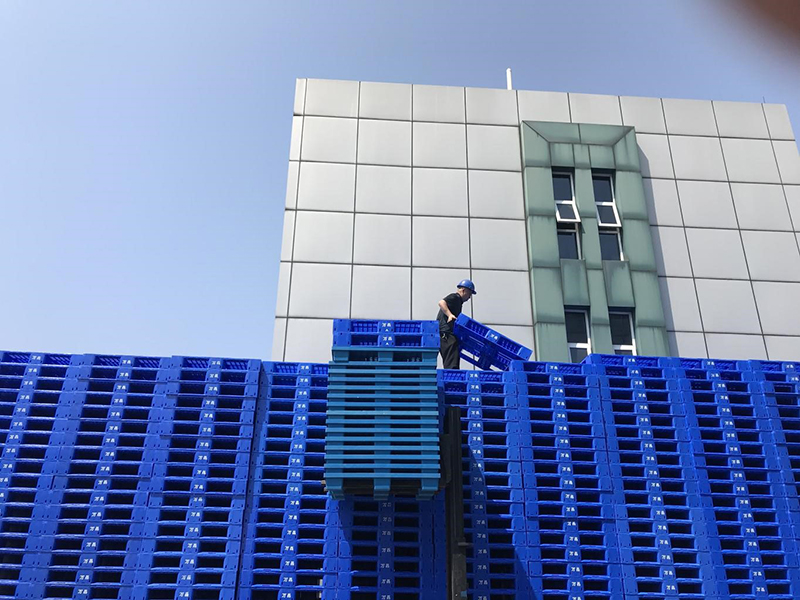

Ensuring a safe working environment for you and your staff is a key benefit of proper pallet stacking and storage practices.
The way you stack and store your plastic pallets also plays a critical role in maintaining the condition of your products.
Nonetheless, the most suitable storage method depends on three primary factors.
- The specific type of stock you possess.
- The frequency with which you need to access it.
- The weight of the load as well as the available space.
Exploring the various pallet stacking techniques can provide valuable insights.
Solutions for Stacking and Storing Pallets
Stacking and Storing Loaded Pallets
When working with loaded pallets, the most important factor is the type of stock and the need for accessibility, especially if dealing with perishable goods like pharmaceuticals or food.
The FIFO (first in, first out) storage system: In the pharmaceutical and food industries, pallets must be arranged so that the oldest products are retrieved first, rather than being covered by newer products.
The LIFO (last in, first out) system: This is the opposite, where pallets are stacked, and the topmost item is the first to be picked.
Storing and Stacking Unloaded Pallets:
Even though the contents on the pallet do not require protection, there are still several safety factors to consider when storing unloaded pallets.

- Maximum Height: The taller the stack, the more hazardous it becomes. A large number of pallets falling from height could lead to significant damage to nearby individuals.
- Pallet Sizes: Different pallet types should be stored separately to ensure a more stable pile.
- Pallet Condition: While it may be tempting to retain damaged pallets, they are also more prone to causing instability in the tower, potentially leading to collapse. Pallets with protruding nails or splintering pose an increased risk of injury if they fall.
- Weather Conditions: Wooden pallets are particularly susceptible to mold and mildew if exposed to moisture or stored in damp environments. This can be problematic for industries where hygiene is crucial, such as the pharmaceutical sector.
- Fire Risk: Regardless of the storage location, wooden pallets present a fire hazard, and the storage arrangements must comply with local safety regulations.
When it comes to unloaded pallets, some of the concerns that must be addressed relate to the material used, as well as the storage method.
Considering the available materials is worthwhile when planning operational needs.
Plastic pallets serve as a particularly good alternative to wood in industries that prioritize hygiene, as they are inherently resistant to mold and pests. Additionally, there is no risk of splinters or loose nails when using plastic pallets.
Pallet Racking

When visualizing a warehouse, pallet racking is often the first thing that comes to mind. This storage solution comes in various forms, including:
- Single-depth racking, which provides direct access to each pallet.
- Double-depth racking, which maximizes storage capacity by placing two pallets deep.
- Conveyor belt flow racking, which utilizes automated mechanisms to move stock.
- Drive-in racking, which enables forklifts to enter the racking structure.
The configuration of the pallet racking system determines whether a FIFO (First-In, First-Out) or LIFO (Last-In, First-Out) inventory management approach is used. The racking can range from simple individual pallet slots to sophisticated automated conveyor systems that handle the movement of stock.
Pallets Stacked in Blocks

In block stacking, loaded pallets are directly placed on the floor and stacked on top of each other.
Block stacking follows LIFO storage system.
The LIFO inventory management aspect is one of the constraints of block stacking. If LIFO is desired, then block stacking can work. However, if LIFO is not required, accessibility to the stored items becomes a significant issue.
According to the article "Block Stacking – Warehouse Basics" by Adapt A Lift:
“Block stacking is a form of palletised storage that does not require any type of storage equipment, and instead loaded pallets are placed directly on the floor and built up in stacks to a maximum stable storage height. Lanes are created to ensure access to the different stock-keeping units (SKUs).”
The pallets are typically stacked in small blocks, such as three units high and three units wide.
Block stacking is a much cheaper option as there are no costs associated with purchasing, installing, and maintaining racking systems. However, accessing the pallets at the bottom requires moving the ones on top. The pallets underneath must also be capable of supporting the weight of the goods stacked above them.
When properly planned, with access and product visibility well-considered, block stacking can provide a great advantage and potentially outperform pallet racking systems.
Pallet Stacking Structures
Pallet stacking frames provide a setup similar to block stacking, but with enhanced weight support capabilities.
The pallet stacking frames fit between each pallet and bear a significant portion of the weight, enabling pallets to be stored on top of each other at greater heights compared to traditional block stacking methods.
